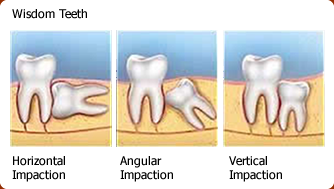
Once a tooth becomes infected to the extent that it can be no longer treated by way of root canal treatment, it should be extracted. Extraction should be done as soon as possible to avoid the spread of infection and more serious problems. Upon removal of the tooth, there might be a requirement for a bridge or an implant.
Surgical Extraction of Wisdom Teeth
When a wisdom tooth is blocked from erupting, it is classified as an impacted tooth. Wisdom teeth can be impacted by the gum tissue overlying them called soft tissue impactions
Wisdom teeth are removed primarily to eliminate the potential for infection and damage to adjacent teeth. The jaws of most individuals are not large enough to accommodate the wisdom teeth and they remain either under the gum tissue where they have a three to five percent chance of becoming cystic or they become partially exposed where they have a much, much greater potential for becoming infected. Infection causes bone loss, damage to adjacent teeth and PAIN. Once it is determined, that there is no room for the wisdom teeth to erupt into a normal position, then the decision is taken to remove the tooth.
Once symptoms of pocketing, swelling, food impaction or pain begin, removal is the most prudent course since the symptoms will not abate until the teeth are removed.